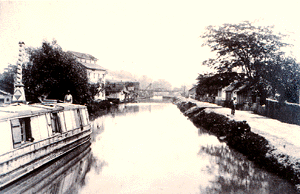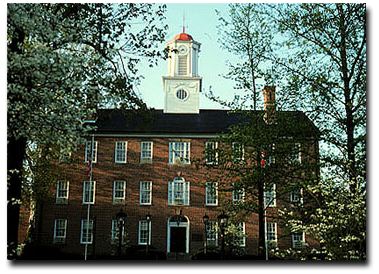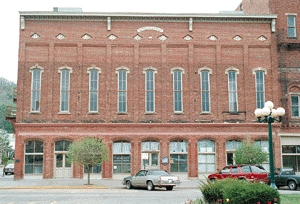
Mound-building Indians, canals, railroads, mining and the first university west of the Appalachian Mountains all contribute to the rich history of Athens County. Today in a growing and bustling county filled with around 60,000 residents, evidence of the past abounds.
Some of the oldest historical sites are Native American burial and ceremonial mounds scattered around the county. Most of these are located in The Plains, located just northwest of Athens on U.S. Rt. 33 and Ohio Rt. 682. The Plains was a religious center of the Adena Indians and also served as a burial ground.

Deceased Indians and some of their belongings were placed in the mounds. Many of the mounds, though, were destroyed when white settlers came in and cleared the land for farming and roads.
One of the more interesting mounds to visit is the one located in the Indian Mound Campground on 7986 Roundhouse Road near New Marshfield. Many of the mounds have been researched by archeologists, but many artifacts from Athens County's earliest residents remain buried.
As white settlements became more established and the land became more populated, mines, mills and furnaces sprouted up in the county. The hills were rich in salt, coal, iron, oil and gas when the settlers arrived.
Often, small communities would form around iron furnaces, providing services and recreation for workers and their families. Remains of these furnaces can be found at sites such as the Lake Hope furnace near just outside Athens county, and the Buckeye Furnace historical site located just to the west in Jackson County.
Coal mining became more and more prevalent, too, with communities formed near the mining works. They include the current Athens county cities and towns of Nelsonville, Glouster, and Millfield. The mines provided good jobs, but often dangerous work, as evidenced by the Millfield Mine disaster that killed 83 workers, the worst mining accident in Ohio history.
On November 5, 1930, 130 miners were working at the Poston No. 6 mine near Millfield, and operation that was to be a model for other mines in the world, when an explosion ripped through the mine just before noon. The mine closed for about four or five weeks, but then re-opened and was in use until V-E Day 1945.
At the time of the explosion, the mine was owned by the Sunday Creek Coal Company, then the second largest coal company in the world. Around 1,500 people lived in Millfield in 1930, many of them working at the mine.
Today, a plaque has been placed at the mine, which is located in Dover Township about one mile east of Millfield. Also, a monument with the names of those who died in the mine has been erected in Millfield, and a commemorative service is held each year in memory of those who died.
Salt was also a major natural resource of Athens County, and exporting it was the most lucrative industry in the county for around 50 years from 1820 to 1870. The Hisylvania Salt mine in Trimble was a fine example. The Indiannapolis 500 race track was built with Trimble bricks. The village of Chauncey, located on Ohio Rt. 13 to the north of Athens, was laid out and built because it was close to a number of saltworks. At the time, the town's founders hoped and believed that Chauncey would become a major business center for the Midwest.
An interesting sidelight involves the pronunciation of the town's name - it's pronounced like "chancey," as in risky. According to local history buffs, that was a deliberate decision. Outsiders, such as scab laborers for the local coal mines or federal prohibition agents, would reveal themselves when they'd mispronounce "Chauncey" as it's spelled (like the name of an English butler).
Other towns, such as Salina, sprung up because of the salt industry and became thriving communities. Along with the saltworks, furnaces, coal mines, grit mills, loading docks and other businesses opened up in these small towns.
The salt industry boomed until after the Civil War when the local market slackened and other areas began competing in the salt market.
Few of the small salt industry towns remain today. Remnants of Salina, though, still stand in the form of an indentation in the river bank, an old rusty railroad and several houses in Dover Township. Also, heavy iron kettles of different sizes once used by the salt industry sit in various places around the county.
Chauncey, although not exactly the business center of the Midwest, is still a thriving community and has had spurts of growth in recent years, all in spite of periodic flooding.

The Hocking Canal made it to Nelsonville in 1842, and the section to Athens was completed in 1843. Salt, coal, pork products, wool and lumber were shipped out of Athens and items such as furniture and iron products were brought into the county by the canal.
Floods, quicker transportation by railroad, problems such as the canal freezing in the winter, and other disadvantages brought the canal system to an end in Athens County in 1890 when the waterway stopped serving Nelsonville.
The last remnants of the Hocking Canal in the city of Athens were bulldozed in 1983 to make way for a housing development, but some evidence remains of the canal system. U.S. Rt. 33 in Nelsonville, also known as Canal Street, is built along the site of the old canal, which is why many of the old homes along the highway are built with their backs to the road.
The first train reached Athens in 1857 by way of the Cincinnati & Marietta Railroad. The rail system quickly became a major method of transportation for area residents while also shipping coal, metal, iron ore, agricultural items and other products out of Athens county.
The railroad still travels through Athens today, but is not used for civilian transportation, and although an old depot still stands off Union Street in Athens, it is not in use. The Glouster Depot, however, continues to be used for community events; and now we have the newly renovated Murray City train depot and Coal Mine Museum showcasing coal mining in the area..
One local train that does still carry
passengers is the Hocking
Valley Scenic Railway. During World War II, the
original 
Hocking Valley Railroad ran 138 steam locomotives, 70 passenger cars and 15,000 freight cars along 340 route-miles of track.
Today, the trains of the Hocking Valley Scenic Railway again pull out of Nelsonville, for pleasure this time, to take passengers on leisurely glides through beautiful, historic Southeastern Ohio.
Two train rides depart from the railroad depot at U.S. Rt. 33 and the Hocking Parkway Drive on Saturdays and Sundays, Memorial Day Weekend through the end of October, with "Santa Specials" the first three weeks of December.
Points of interest along the rail route in and around Nelsonville Yards, once the busiest railroad yard in the state; the old Nelsonville brick kilns; the historic Dew Hotel, where presidents Taft, McKinley, Harding and Roosevelt campaigned; Stuart's Opera House, built in 1879; old canal locks; and the Rocky Boot Outlet in Nelsonville. For more information about the Hocking Valley Scenic Railway, call (513) 335-0382 between 10 a.m. and 4 p.m. weekdays, or (614) 753-9531 weekends.
While we're talking about mass transportation in Athens County, we can't forget the trolley cars that served Athens County from 1912 through 1933, taking residents between locations such as Chauncey, Nelsonville and Athens, much of the time following the trail of the canal.
Besides being a leader in mining and industry in its early history, Athens County was also a leader in education. Athens, in fact, is named after Athens, Greece, because here, as in Greece, Athens is known as a center for learning.
Most parts of the county had their own schoolhouses, and the village of Albany, located on U.S. Rt 32/50 southwest of Athens, had a school for African-American children in the late 1800s called the Enterprise Academy.
Ohio University, the first university of the Northwest Territory, was established in Athens in 1804 and opened for classes in 1808. One of the first two graduates of the university was Thomas Ewing, who went on to become a U.S. Senator, cabinet member and adviser to four U.S. Presidents. In 1828, John Newton Templeton became the first black graduate of Ohio University and the fifth African American to graduate from any college in America.
The campus has many historic buildings, including Cutler Hall on the College Green, which opened in 1819 and is the oldest existing college building in Ohio.

Hocking College opened in Nelsonville 1968, then with the name Tri-County Technical College. Nearly 6,000 students are now enrolled at the college, which serves as another source for advanced education for area residents and an economic boom for the county.
Many historic businesses still reside in Athens County, including Rocky Shoes and Boots in Nelsonville. The Company opened in 1932 and now sells shoes and boots worldwide. Rocky also has a huge new factory outlet in Nelsonville, next to the factory. Tours of the factory can be arranged with advance notice. (753-3130)

Among the many other historical sites in the county are Stuart's Opera House in Nelsonville, a theater currently under renovation that will be used for plays and community activities; the Athens County Historical Society and Museum, located on Court Street in Athens; and the Boy Scout Museum in Glouster. To learn about the many other historical sites in the region, a good place to start is the Athens County Historical Society and Museum. .A great resource for researching the area's rich roots can be found through the extensive collection at the Athens County Historical Society and Museum (65 North Court Street in Athens). Since 1976, ACHS&M has acquired and preserved more than 20,000 items ranging from toys, books, clothing, photographs and other historical and cultural artifacts. (740-592-2280)
This webpage was created by the Athens county Chamber of Commerce and Athens County Convention and Vistor's Bureau Websites.
| accvb@eurekanet.com |
all rights reserved